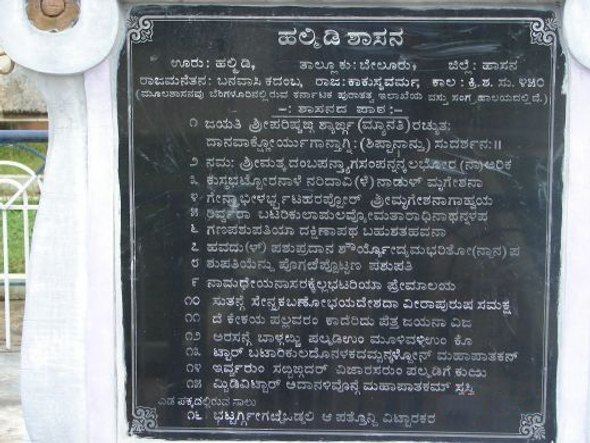Type Abugida Sister systems Telugu
Sinhala
Mon | Time period 5th century–present Direction Left-to-right | |
 | ||
Languages Kannada
Tulu
Kodava
Badaga
Beary
Sanketi
Konkani
Sanskrit Parent systems Egyptian hieroglyphs
Proto-Sinaitic script
Phoenician alphabet
Aramaic alphabet
Brahmi script
Kadamba alphabet
Kannada Alphabet | ||
The Kannada alphabet (IAST: Kannaḍa lipi) is an alphabet of the Brahmic family, used primarily to write the Kannada language, one of the Dravidian languages of South India especially in the state of Karnataka, Kannada script is widely used for writing Sanskrit texts in Karnataka. Several minor languages, such as Tulu, Konkani, Kodava, Sanketi and Beary, also use alphabets based on the Kannada script. The Kannada and Telugu scripts share high mutual intellegibility with each other, and are often considered to be regional variants of single script. Other scripts similar to Kannada script are Sinhala script (which included some elements from the Kadamba script), and Old Peguan script (used in Burma).
Contents
- History
- Vowel letters
- Yogavaahas
- Consonant letters
- Structured consonants
- Unstructured consonants
- Consonant Conjuncts
- Numerals
- Akshara
- In popular culture
- References
The Kannada script (ಅಕ್ಷರಮಾಲೆ akṣaramāle or ವರ್ಣಮಾಲೆ varṇamāle) is a phonemic abugida of forty-nine letters, and is written from left to right. The character set is almost identical to that of other Brahmic scripts. Consonantal letters imply an inherent vowel. Letters representing consonants are combined to form digraphs (ಒತ್ತಕ್ಷರ ottakṣara) when there is no intervening vowel. Otherwise, each letter corresponds to a syllable.
The letters are classified into three categories: ಸ್ವರ svara (vowels), ವ್ಯಂಜನ vyan̄jana (consonants), and ಯೋಗವಾಹಕ yōgavāhaka (part vowel, part consonant).
The Kannada words for a letter of the script are ಅಕ್ಷರ akshara, ಅಕ್ಕರ akkara, and ವರ್ಣ varṇa. Each letter has its own form (ಆಕಾರ ākāra) and sound (ಶಬ್ದ śabda), providing the visible and audible representations, respectively. Kannada is written from left to right.
History
The Kannada script derives from the Old Kannada script, which evolved around 10th century as the continuation of the Kadamba alphabet of the fourth century. This evolved from the ancient Brahmi script of the third century BCE.
Over the centuries some changes have been made to the Kannada script. These changes consist of:
- Modification of existing glyphs: In the early Kannada script, no orthographic distinction was made between the short mid [e, o] ಎ, ಒ and long mid [eː, oː] ಏ, ಓ. However, distinct signs were employed to denote the special consonants viz. the trill [r] ಱ the retroflex lateral [ɭ] ಳ and the retroflex rhotic [ɺ] ೞ found only in South Indian languages, by 5th century.
- Introduction of new characters: Kannada script includes characters like [ç] ಶ, [ʂ] ಷ, [rɨː] ೠ, [lɨ] ఌ, [lɨː] ౡ, [eʲ] ಐ, [oʷ] ಔ, [am] ಅಂ, [ah] ಅಃ, and mahāprāṇa characters like [kʰ] ಖ, [ɡʱ] ಘ, [tʃʰ] ಛ, [dʒʱ] ಝ, [t̪ʰ] ಥ, [d̪ʱ] ಧ, [ʈʰ] ಠ, [ɖʱ] ಢ, [pʰ] ಫ, [bʱ] ಭ. The introduction was done so that Sanskrit (and loanwords into the Kannada language from the donor language Sanskrit) could be written using the Kannada script.
These changes have facilitated the use of the Kannada script for writing many of the literary Indic languages, including Sanskrit.
Vowel letters
There are thirteen vowel letters (ಸ್ವರ svara).
When a vowel follows a consonant, it is written with a diacritic rather than as a separate letter.
Yogavaahas
The Yōgavāha (part-vowel, part consonant) include two letters:
- The anusvara: ಅಂ (aṁ)
- The visarga: ಅಃ (aḥ)
Another two Yōgavāha used in Sanskrit, but present in Kannada script, are known as Ardhavisarga:
- The Jihvamuliya: ೱ
- The Upadhmaniya: ೲ
Consonant letters
Two categories of consonant letters (ವ್ಯಂಜನ vyan̄jana) are defined in Kannada: the structured consonants and the unstructured consonants.
Structured consonants
The structured consonants are classified according to where the tongue touches the palate of the mouth and are classified accordingly into five structured groups. These consonants are shown here with their IAST transcriptions.
See place of articulation for more information on tongue positions.
Unstructured consonants
The unstructured consonants are consonants that do not fall into any of the above structures:
ಯ (ya), ರ (ra), ಱ (ṟa) (obsolete), ಲ (la), ವ (va), ಶ (śa), ಷ (ṣa), ಸ (sa), ಹ (ha), ಳ (ḷa), ೞ (ḻ) (obsolete).
Consonant Conjuncts
The Kannada script is rich in conjunct consonant clusters, with most consonants having a standard subjoined form and few true ligature clusters. A table of consonant conjuncts follows, although the forms of individual conjuncts may differ according to font.
Numerals
The decimal numerals in the script are:
Akshara
Written Kannada is composed of akshara or kagunita, corresponding to syllables. The letters for consonants combine with diacitics for vowels. The consonant letter without any diacritic, such as ಕ ka, has the inherent vowel a ಅ. This is called ದೀರ್ಘ deergha. A consonant without a vowel is marked with a 'killer' stroke, as ಕ್ k. This is known as hrasva ಹ್ರಸ್ವ.
* This diacritic has the form ಿ when combined with other consonant letters.
The formations shown boldface above are seldom used in the normal course of the language.
Kannada alphabet equivalent given in English & Devanagari (Hindi) script.
In popular culture
Due to its resemblance to an eye and an eyebrow, the Kannada letter ಠ ṭha is used in a popular emoticon called the look of disapproval, which is displayed as ಠ_ಠ. It is used to convey disapproval or contempt. Similarly, the akshara ರೃ rr̥a has been used in an emoticon to represent a monocle.
